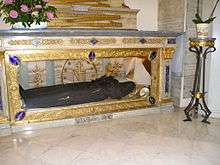Shrine


A shrine (Latin: scrinium "case or chest for books or papers"; Old French: escrin "box or case")[1] is a holy or sacred place, which is dedicated to a specific deity, ancestor, hero, martyr, saint, daemon, or similar figure of awe and respect, at which they are venerated or worshipped. Shrines often contain idols, relics, or other such objects associated with the figure being venerated.[2] A shrine at which votive offerings are made is called an altar. Shrines are found in many of the world's religions, including Christianity, Islam, Hinduism, Buddhism, Chinese folk religion, Shinto, and Asatru as well as in secular and non-religious settings such as a war memorial. Shrines can be found in various settings, such as churches, temples, cemeteries, or in the home, although portable shrines are also found in some cultures.[3]
A shrine may become a focus of a cult image.
Types of shrines

Temple shrines
Many shrines are located within buildings and in the temples designed specifically for worship, such as a church in Christianity, or a mandir in Hinduism. A shrine here is usually the centre of attention in the building, and is given a place of prominence. In such cases, adherents of the faith assemble within the building in order to venerate the deity at the shrine. In classical temple architecture, the shrine may be synonymous with the cella.
Household shrines
Historically, in Hinduism, Buddhism and Roman Catholicism, and also in modern faiths, such as Neopaganism, a shrine can commonly be found within the home or shop.[4] This shrine is usually a small structure or a setup of pictures and figurines dedicated to a deity that is part of the official religion, to ancestors or to a localised household deity.[5]
Small household shrines are very common among the Chinese and people from South and Southeast Asia, whether Hindu, Buddhist or Christian. Usually a small lamp and small offerings are kept daily by the shrine. Buddhist household shrines must be on a shelf above the head; Chinese shrines must stand directly on the floor.
Yard shrines
Small outdoor yard shrines are found at the bottom of many peoples gardens, following various religions, including historically, Christianity. Many consist of a statue of Christ or a saint, on a pedestal or in an alcove, while others may be elaborate booths without ceilings, some include paintings, statuary, and architectural elements, such as walls, roofs, glass doors and ironwork fences, etc.
In the United States, some Christians have small yard shrines; some of these resemble side altars, since they are composed of a statue placed in a niche or grotto; this type is colloquially referred to as a bathtub madonna.[6]
Religious shrines
Shrines are found in most, though not all, religions. As distinguished from a temple, a shrine usually houses a particular relic or cult image, which is the object of worship or veneration, or is constructed to set apart a site which is thought to be particularly holy, as opposed to being placed for the convenience of worshippers. Shrines therefore attract the practice of pilgrimage.[7][8]
Christianity
Shrines are found in many, though not all, forms of Christianity. Roman Catholicism, the largest denomination of Christianity,[9] has many shrines, as do Orthodox Christianity and Anglicanism.

In the Roman Catholic Code of Canon law, canons 1230 and 1231 read: "The term shrine means a church or other sacred place which, with the approval of the local Ordinary, is by reason of special devotion frequented by the faithful as pilgrims. For a shrine to be described as national, the approval of the Episcopal Conference is necessary. For it to be described as international, the approval of the Holy See is required."[10]
Another use of the term "shrine" in colloquial Catholic terminology is a niche or alcove in most – especially larger – churches used by parishioners when praying privately in the church. They were also called Devotional Altars, since they could look like small Side Altars or bye-altars. Shrines were always centered on some image of Christ or a saint – for instance, a statue, painting, mural or mosaic, and may have had a reredos behind them (without a Tabernacle built in).
However, Mass would not be celebrated at them; they were simply used to aid or give a visual focus for prayers. Side altars, where Mass could actually be celebrated, were used in a similar way to shrines by parishioners. Side altars were specifically dedicated to The Virgin Mary, Saint Joseph as well as other saints.
A nativity set could also be viewed as a shrine, as the definition of a shrine is any holy or sacred place.
Islam
Sunni Islam
More than any other tomb in the Islamic world, the shrine of the Prophet Muhammad (s) is considered a source of blessings for the visitor.[11] A famous hadith of the Prophet states that, "He who visits my grave will be entitled to my intercession" and in a different version "I will intercede for those who have visited me or my tomb."[11][12][13] Visiting the Prophet's tomb after the pilgrimage is considered by the majority of Sunni legal scholars to be recommended.[14]
Muslims desire to be buried near the tombs of people who are famous for their knowledge or piety. As an example, the son of Imam Ahmed ibn Hanbal reportedly stated that he would prefer to be buried near the shrine of a saintly person than his own father.[15]

Shia

Shia's have several shrines dedicated to various religious figures important in their history, and several elaborate shrines are dedicated to Shia Saints and religious figures, most notably in Kerbala, Najaf, and Samarra in Iraq, and Qum and Mashad in Iran. Other important Shia shrines are located in Mazar-e-Sharif ("the Noble Shrine") in Afghanistan, and in Damascus, Syria.
Opposition to shrines
Although shrines are prevalent in many parts of the Muslim world, Muslims who follow the Wahhabi sect do not condone the practice of visiting and building shrines. Many shrines have been demolished arousing the opposition of Sunni Muslims. Ali Gomaa, Grand Mufti of the oldest Sunni University Al Azhar, has criticized the destruction of shrines and public property as unacceptable,[16] as has the Grand Imam of Al-Azhar Ahmed el-Tayeb, head of the Islamic Research Centre of Egypt.[17]
Bahá'í

The two most well-known Bahá'í shrines serve as the resting places for the respective remains of the two central figures of the Bahá'í Faith, the Báb and Bahá'u'lláh. They are the focal points of a Bahá'í pilgrimage:
- The Shrine of the Báb in Haifa, Israel.[18]
- The Shrine of Bahá'u'lláh in Acre, Israel.[19]
Other sites have been designated as Bahá'í Shrines, the most notable being the home of William Sutherland Maxwell and May Maxwell in Montreal, Quebec, Canada.[20]
Buddhism

In Buddhism, a shrine refers to a place where veneration is focused on the Buddha or one of the bodhisattvas. Monks, nuns and laypeople all give offerings to these revered figures at these shrines and also meditate in front of them.
Typically, Buddhist shrines contain a statue of either the Buddha, or (in the Mahayana and Vajrayana forms of Buddhism), one of the various bodhisattvas.[21] They also commonly contain candles, along with offerings such as flowers, purified water, food, and incense. Many shrines also contain sacred relics, such as the alleged tooth of the Buddha held at a shrine in Sri Lanka.
Site-specific shrines in Buddhism, particularly those that contain relics of deceased buddhas and revered monks, are often designed in the traditional form known as the stupa.
Germanic paganism
In Germanic paganism, types of shrines were employed, but terms for the shrines show some level of ambiguity:
- Hörgrs, which may have originally exclusively referred to "holy places", whereas its Old English cognate hearg could mean "holy grove" and/or "temple, idol"[22]
- Vés (Old Norse) or wēohs (Old English), referring to either a types of shrines or sacred enclosures. The term appears in skaldic poetry and in place names in Scandinavia (with the exception of Iceland), often in connection with a Norse deity or a geographic feature. The name of the Norse god Vé, refers to the practice.[23]
Hinduism
In Hinduism, a shrine is a place where a god or goddess is worshipped. Shrines are typically located inside a temple known as a mandir, though many Hindus also have a household shrine as well. Sometimes a human is venerated at a Hindu shrine along with a deity, for instance the 19th century religious teacher Sri Ramakrishna is venerated at the Ramakrishna Temple in Kolkata, India.
Central to a Hindu shrine is a statue of a deity, which is known as a murti. Hindus believe that the deity that they are worshiping actually enters and inhabits the murti. This is given offerings like candles, food, flowers, and incense. In some cases, particularly among devotees of the goddess Kālī in northern India, animals are sacrificed to the deity.
At a mandir, the congregation often assembles in front of a shrine, and, led by priests, give offerings and sing devotional hymns.
Taoism
The line between a temple and a shrine in Taoism is not fully defined; shrines are usually smaller versions of larger Taoist temples or small places in a home where a yin-yang emblem is placed among peaceful settings to encourage meditation and study of Taoist texts and principles. Taoists place less emphasis on formalized attendance and ritualized worship than other Asian religions; formal temples and structures of worship came about in Taoism mostly in order to prevent losing adherents to Buddhism.[24] Frequent features of Taoist shrines include the same features as full temples, often including any or all of the following features : gardens, running water or fountains, small burning braziers or candles (with or without incense), and copies of Taoist texts such as the Tao Te Ching, Zhuangzi or other texts by Lao Tzu, Chuang Tzu or other Taoist sages.
As with all Taoist worship, Taoist shrines are organized around a sense of appreciation of nature and surroundings that inspire meditation on, and living in accordance with, the Tao ("Way" or "Path", a concept of living harmoniously with one's natural surroundings and environment) and the Three Jewels Of Taoism (different from Buddhism's concept of Three Jewels) – compassion, moderation, and humility.
Secular shrines
In the United States and some other countries, landmarks may be called "historic shrines." Notable shrines of this type include:
- The Alamo in San Antonio, Texas, U.S.
- Fort McHenry in Baltimore, Maryland, U.S.
- Touro Synagogue in Newport, Rhode Island, U.S.
- Shrine of Remembrance, a war memorial in Melbourne, Australia
- Shrine of Remembrance, a war memorial in Brisbane, Australia
- Lenin's Mausoleum in Moscow, Russia
- Kumsusan Palace of the Sun in Pyongyang, Korea
Halls of fame also serve as shrines into which single or multiple individuals are inducted on the basis of their influence upon regions, cultures or disciplines. Busts or full-body statues are often erected and placed alongside each other in commemoration.
By extension the term shrine has come to mean any place dedicated completely to a particular person or subject such as the Shrine of the Sun in Colorado Springs, Colorado.[25]
See also
- List of shrines
- Makeshift/roadside memorial
- Ancient Arabic Order of the Nobles of the Mystic Shrine
- Holiest sites in Islam (Shia)
- Holiest sites in Islam (Sunni)
- Shrines to the Virgin Mary
- Numen
References
- ↑ Harper, Douglas. "shrine". Online Etymology Dictionary.
- ↑ Shrine. thefreedictionary.com
- ↑ Portable Tibetan Shrine. British Museum
- ↑ Patricia Chang (February 23, 2007). "Shrines in shops in Chinatown". Downtown Express. 19 (41).
- ↑ Household Shrines. Gualala Arts
- ↑ Front Yard Shrines. catholichomeandgarden.com
- ↑ Catholic Shrines. Sacred Destinations
- ↑ David Tyson (1997). "Shrine pilgrimage in Turkmenistan as a means to understand Islam among the Turkmen". Central Asia Monitor. 1.
- ↑ Wikipedia Roman Catholic Church
- ↑ PART III : SACRED PLACES AND TIMES. ourladyswarriors.org
- 1 2 Diem, Werner; Schöller, Marco (2004-01-01). The Living and the Dead in Islam: Indices. Otto Harrassowitz Verlag. p. 46. ISBN 9783447050838.
- ↑ Bayhaqi. Sunan. V. p. 245.
- ↑ Iyyad, Qadi. Shifa. II. p. 71.
- ↑ Diem, Werner; Schöller, Marco (2004-01-01). The Living and the Dead in Islam: Indices. Otto Harrassowitz Verlag. p. 55. ISBN 9783447050838.
- ↑ Diem, Werner; Schöller, Marco (2004-01-01). The Living and the Dead in Islam: Indices. Otto Harrassowitz Verlag. pp. 7–8. ISBN 9783447050838.
- ↑ "Salafi destruction of shrines and public property unacceptable". Ikhwanweb. Retrieved 24 February 2013.
- ↑ "Salafi Violence against Sufis". Retrieved 24 February 2013.
- ↑ Bahá'í World Centre (2007). "Shrine of the Báb". Bahá'í World Centre. Retrieved 2009-02-03.
- ↑ Bahá'í World Centre (2007). "Shrine of Bahá'u'lláh". Bahá'í World Centre. Retrieved 2009-02-03.
- ↑ Bahá'í Community of Canada (2014). "Bahá'í Shrine in Canada". Bahá'í Community of Canada. Retrieved 2014-12-06.
- ↑ Srine. buddhamind.info
- ↑ Rudolf Simek (2007), translated by Angela Hall. Dictionary of Northern Mythology, p. 156. D.S. Brewer. ISBN 0-85991-513-1
- ↑ Simek, Rudolf (2007), translated by Angela Hall. Dictionary of Northern Mythology, page 335. D.S. Brewer. ISBN 0-85991-513-1. and Orchard, Andy (1997). Dictionary of Norse Myth and Legend, page 173. Cassell. ISBN 0-304-34520-2
- ↑ Facts and Details – Organized Taoism, Retrieved 2008-10-28.
- ↑ "Will Rogers Shrine of the Sun". Artsopolis Network. Retrieved December 30, 2011.
External links
| Wikimedia Commons has media related to Shrines. |
- Shrines of British Saints by J. Charles Wall. Full Text + Illustrations.
- GCatholic.org
- Hari Parbat
- Top Catholic Shrines in the U.S.

